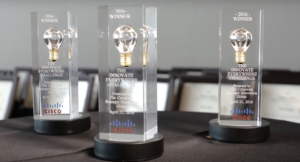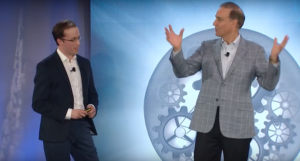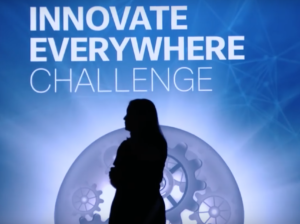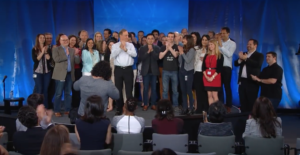The Cisco Innovate Everywhere Challenge – And Its Aftermath
“Steve, that was fantastic. In fact, a finalist just told me that the Innovate Everywhere Challenge has been their best experience EVER at Cisco,” said Alex Goryachev, Cisco Director of Innovation. Alex gave me this feedback right after our Cisco TV broadcast to name the Grand Prize winners.
So how did we get here?
“Our history is rooted in innovation, disruption, and market transitions. Since 1984, we’ve been at the forefront of technology: networking, voice over IP, collaboration, virtualization, cloud, video, mobility, and the Internet of Everything.
“It’s what we do. It’s what you can do, too.”
– Cisco.com
“New Cisco CEO Chuck Robbins favors small, internal ‘start-up’ teams over funding and acquiring companies”
– Network World headline, November 16, 2015
Not long after taking the helm at networking hardware giant Cisco Systems, CEO Chuck Robbins made a bold statement to Network World. He and his new leadership team would emphasize “small internal ‘start-ups’ for innovation, rather than forming, funding and acquiring spin-in companies to develop new products for key markets.”
To reinvigorate internal start-ups, Robbins would give select internal teams “big hairy problems” to solve. Among them: data center security, service provider routing, and software, data and analytics to advance the much-ballyhooed Internet of Things.
Against this backdrop of a changing approach to drive innovation at Cisco, my 2014 presentation at the Lean Startup Conference in San Francisco caught the eye of Oseas Ramirez Assad. He manages Cisco’s Leadership Pipeline.
The Leadership Pipeline develops professionals and introduces new leadership skills to the top 2% of talent at Cisco. Oseas asked if I would teach and consult for the Leadership Pipeline on Lean Startup skills in large organizations, based on my years of experience at GE.
After a few months of intensive inculcation, we successfully converted many of the top 2% to apply Lean Startup ideas in Cisco.
This work led to my first meeting with Alex Goryachev. At the time, Alex was making plans to launch a new internal version of the extraordinarily successful Cisco Innovation Grand Challenges.
These high-profile contests invite the entire world of tech entrepreneurs, startups and investors to pitch their best ideas to teams of judges at Cisco. Cisco publicly announces the annual winners of the Grand Challenge with great fanfare.
Alex’s idea: why not take this concept and apply it inside Cisco? Make a challenge in which the winners, Cisco employees, would receive accolades and exposure plus seed money and access to development resources, opportunities and expertise?
What a cool idea! I thought. What a great way to unleash internal innovation.
The new internal Grand Challenge, Alex said, would be called the “Cisco Innovate Everywhere Challenge.” Needless to say, I was hooked.

Winners of the Cisco Employee Challenge received cash, funding and time to work on their innovations.
That meeting with Alex propelled me onto the next leg of my Cisco journey: I helped the Leadership Pipeline work with ideas from Alex and his team. To me, it felt like we were on to something really special.
As Alex told Innovation Leader, “We’re an amazing company with 30 years’ history of innovation. It’s a phenomenal place to work. As we get older, we’re certainly getting smarter and wiser, but we get slower as well … The industry is going through a rapid shift. Every day, we’re discovering new startups, new competitors. We’re challenged in every marketplace where we operate.
“The world is changing, and it’s changing overnight. The new ideas, they’re rapidly coming from everywhere. The change is really exponential … We wanted to make sure that we increase [our] speed, and we create a new culture of innovation.”
A while later, Alex called, bubbling with excitement. He told me that employee response to the Innovate Everywhere call for submissions was overwhelming. Out of Cisco’s 70,000 worldwide employees, more than 2,000 employees had worked on an astounding 1,100 separate submissions.
“Frankly, I never really expected that so many people would participate. We were a bit blown away by that,” Alex said.
“We didn’t limit those ideas [to] technology. Being a tech company, we have a strong history of tech innovation. What we wanted to do is listen to business ideas. We’ve encouraged people to come up with new business models, [but there is] one catch: as long as it’s not something that they do during their day job at Cisco.”
In and of itself, the number of submissions was incredible news. It was perfect, tangible proof of our mutually shared, deep-seated conviction that out somewhere out there in the vast universe of Cisco was huge untapped talent.
Within its deep pool of 70,000 creative souls resided a powerful, supremely valuable asset: a hitherto-untapped pool of technical talent. We only needed a process of alchemy to access it – by using the right tools, by offering the right encouragement and acknowledgement.
For the challenge, my role was not to be a technical advisor, but to be a “corporate entrepreneurial” coach.
A slew of committees of technical experts winnowed down the 1,100 entries to 15 semi-finalists. Those 15 teams and their leaders got hands-on training at our 3-day intensive workshop.
Then an internal committee selected 6 finalists from among the semi-finalists. Those 6 finalists were eventually narrowed down to 3 winning teams.
These winning teams would receive not only accolades and recognition, but also carefully constructed combinations of rewards and incentives. Those included extensive exposure to senior managers and leaders, seed money, and tailored access to talent and expertise inside Cisco to help bring ideas from concept to fruition to the marketplace.
“One of the key things that we did is, if you win the challenge, you and your team get three months off, paid innovation time, to go and innovate, and focus on your ideas. That was the most important incentive,” Alex said.
The entire journey from concept to market, of course, was urgently accelerated according to Lean and Agile Startup methods and principles.
For someone like me, with a background in marketing, a pivotal point in the process came in the first round of semi-finalist presentations. The pitches were, in a word, “Ugh!”
I was fascinated that, while the first 15 ideas must have been technically terrific, their presentation skills left something to be desired. So we added extensive presentation coaching, which turned out to be a key to making the process work.
We needed to get engineers and technicians to come up with compelling stories and frame the stories not in technical terms, but in terms of real-life solutions to well-defined customer problems.
“If you have no customer interaction, you really have no product. Only the customer knows what’s good and bad. By rapid prototyping with the customers, you can actually validate things pretty quickly, and pivot, or continue,” Alex said. “We’re doing a lot of that at our innovation centers, where we work with customers in a rapid prototyping mode.”
This viewpoint draws an essential distinction between two kinds of innovation. Framing the story in technical terms is all-too-commonly practiced in companies with technical and engineering cultures. But the customer-driven innovation is can be accelerated rapidly precisely because it’s aimed squarely at solving a customer problem, dilemma, hassle or friction point.
The compelling presentation of an idea, the telling of the customer-solution story, is axiomatic in and around Silicon Valley and the venture capital community. Telling the story well is as critical, if not more critical, to an idea’s long-term success as its technical quality.
Yet, that’s often still news to people who are not steeped in hard-charging entrepreneurial cultures. That was precisely that kind of culture that we aimed to foster inside Cisco.
Then came the kicker, for me at least. Alex called to say he was planning to be in my neck of the woods for a meeting, and asked to have breakfast with me. A few seconds into the meal, he casually dropped a minor bombshell. “Steve, are you busy on April 22nd?”
Frankly, I hesitated, not entirely sure what might be coming.
“I think so. Depends on what you’ve got in mind.”
What Alex had in mind put me, two weeks later, in an armchair in a green room adjacent to a Cisco TV studio in San Jose, where a stylist was skillfully applying makeup to my face.
I was sweating bullets. In a few minutes I’d be playing the role of emcee and host of a Shark Tank-style reality TV show, broadcast live on Cisco TV. The show not only would reach thousands of Cisco employees around the world live, but also hundreds of people in a live studio audience including senior executives.
Believe me, it was 100% Alex Gorychev’s idea – not mine – to produce a spectacular grand finale to the Cisco Everywhere Innovation Challenge.
It was his idea to make the internal innovation process seem dramatic, even sexy. Sure enough, an unprecedented number of employees tuned in live or watched a download.
I won’t go into the details of the show here because frankly, I can’t. The ideas presented were proprietary. While I would truly love to share them with you, I just can’t.
But I can leave you with one parting shot. While all those brilliant ideas percolated and incubated deep within a newly energized Cisco, here are 3 lessons I learned from helping to launch and execute the first-ever Cisco Innovate Everywhere Challenge.
- Even large organizations have an abundance of “mavericks” bursting with exceptional ideas and passion to grow the firm’s business. You just need to figure out a great way to tap into their talent, energy and enthusiasm.
- Every large organization has plenty of senior execs who actually “get it” and are eager and willing to publically engage and support making this happen.
- It often takes a genuine public catalyst or “Internal Disruptive Innovation” to show both parties that the other one really cares!
Suffice it to say: while there were 3 final winners, the ultimate winners may well number in the hundreds, if not thousands. That’s not to mention the potential millions of customers and users who may someday be touched by the products Cisco ultimately brings to market from the Challenge.
But long before that, we saw winners aplenty. That’s because an apparently common, quite unexpected, outcome of the challenge was that people connected across Cisco.
Employees in one corner of the far-flung Cisco community ended up contacting colleagues in distant geographies and lines of businesses to offer their services. The calls came simply because employees were intrigued by an idea they’d seen at the Challenge. That’s how the Innovate Everywhere Challenge stoked a positive vibe across the whole global organization.
“At the end of the day, everything comes down to people, not technology,” Alex said. “It’s the people that create value. …Our goal was changing the mindset. It’s making sure that [employees] know that they don’t need a permission from anyone to innovate. They can innovate in their day jobs. They can act more like entrepreneurs.”
Something else also happened that day, which I need to share with you before I go.
After the show, I got this email from Alex:
From: Alex Goryachev
To: Stephen Liguori <steve@liguoriinnovation.com>
Subject: you are going to love this
Steve,
Thank you again! Not sure if you are considering a second career in show business, but folks are raving about you:
[Here is a note I just received from someone who caught our show by attending the pitches live in San Jose]:
This was such a cool company-wide initiative!
It says a lot about Cisco’s evolving and highly adaptive culture.
It’s evidence of genuine inquisitiveness among the Cisco population and an eagerness to reach out to peers, transcend boundaries of functions and geographies to work together, to grapple with ideas, to innovate.
I thought the energy in the room was infectious. Each team brought their A-game to the podium and was passionate in presenting and defending their ideas.
And I really liked the event emcee. He kept everyone’s nerves at bay. He drew out the stories about teaming up. He let us hear directly from the participants on how each one of us can do what they did.
Note to readers: I hereby solicit any and all proposals to host any reality-TV shows about innovation you might care to produce at any point in the near or far future.
My rates might be low, but my value-added is, I promise, high. References upon request.
Okay, I’m only kidding.
Until next time, I’m Steve Liguori.
By the way, here is Cisco’s video on the Innovate Everywhere Challenge:



